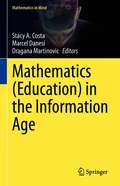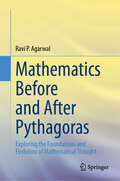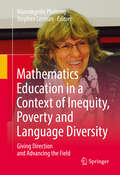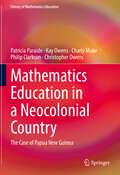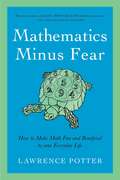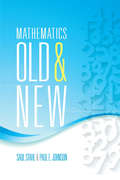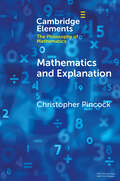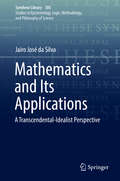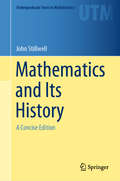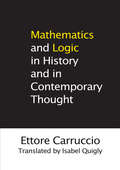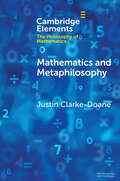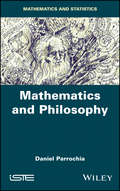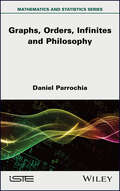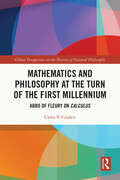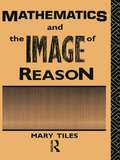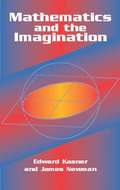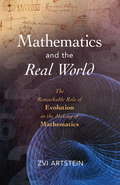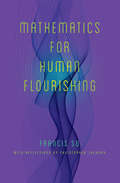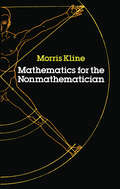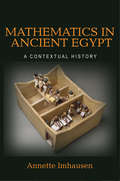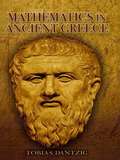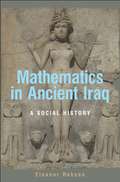- Table View
- List View
Mathematics
by David J. Chard Earlene J. Hall Edward B. Burger Jennie M. Bennett Paul A. Kennedy Freddie L. Renfro Tom W. Roby Janet K. Scheer Bert K. WaitsThe topics described in the Standards for Mathematical Content will vary from year to year. However, the way in which you learn, study, and think about mathematics will not. The Standards for Mathematical Practice describe skills that you will use in all of your math courses.
Mathematics (Mathematics in Mind)
by Marcel Danesi Dragana Martinovic Stacy A. CostaThis book brings together ideas from experts in cognitive science, mathematics, and mathematics education to discuss these issues and to present research on how mathematics and its learning and teaching are evolving in the Information Age. Given the ever-broadening trends in Artificial Intelligence and the processing of information generally, the aim is to assess their implications for how math is evolving and how math should now be taught to a generation that has been reared in the Information Age. It will also look at the ever-spreading assumption that human intelligence may not be unique—an idea that dovetails with current philosophies of mind such as posthumanism and transhumanism. The role of technology in human evolution has become critical in the contemporary world. Therefore, a subgoal of this book is to illuminate how humans now use their sophisticated technologies to chart cognitive and social progress. Given the interdisciplinary nature of the chapters, this will be of interest to all kinds of readers, from mathematicians themselves working increasingly with computer scientists, to cognitive scientists who carry out research on mathematics cognition and teachers of mathematics in a classroom.
Mathematics Before and After Pythagoras: Exploring the Foundations and Evolution of Mathematical Thought
by Ravi P. AgarwalThis book provides the reader with a comprehensive account of the contributions of Pythagoras to mathematics and philosophy, using them as a starting point to compare pre-Pythagorean accomplishments with the myriad mathematical developments that followed. It begins with a thorough study of Pythagoreanism and the early Pythagoreans, including the major events in Pythagoras' life and the origins of the mystical significance attributed by Pythagoreans to natural numbers. From Chapter 3 onward, the book describes how mathematical thinking works and prepares the reader for the subsequent chapters, which cover mathematical logic and proofs, their application to the study of natural and prime numbers, the investigation of Pythagorean triples, figurative numbers, and irrational numbers, all interwoven with rich historical context. Aimed at students and teachers at all levels, this work is accessible to non-mathematicians as well, with the main prerequisite being an avid curiosity about some of the ideas and thinkers that helped to forge the mathematical world as we know it. Early praises for “Mathematics Before and After Pythagoras”: “Your book is charming and fun to read. It would be fine to be able to teach from it.” (Steve Krantz, USA) “...your new book, an obvious labor of love... I can see that it will be an inspiration for young students.” (Bruce Berndt, USA) “It is an excellent book, and I am deeply grateful for sending it to me. It is an extraordinary gift, and I am so grateful for this.” (Carlo Cattani, Italy) “I am really impressed by the wealth of interesting material you have collected and presented.” (Rainer Kress, Germany)
Mathematics Education in a Context of Inequity, Poverty and Language Diversity
by Mamokgethi Phakeng Stephen LermanThis volume is dedicated to the career of Jill Adler and the role she has played in growing mathematics education research in South Africa, Africa and beyond. Her work epitomises what is referred to as the 'engaged scholar': i. e. doing rigorous and theoretically rich research at the cutting edge of international work in the field which at the same time contributes to critical areas of local and regional need in education. Jill is one of the world's leading experts in mathematics education research and her exemplary career is a continuous source of inspiration for generations of researchers and students. The chapters in this volume are authored by Jill's former PhD students, a few select colleagues from different parts of the world that she collaborated with as well as leading scholars who she worked with in PME, ICMI and in her many international assignments. In essence, this volume celebrates Jill's contribution not only to mathematics education but also to our contributions as her friends and colleagues. Topics covered include language and mathematics, teacher education, and the dilemma of an activist researcher engaging in issues that matter hugely to the participants in the research, students and teachers in post-apartheid schooling, whilst also setting up the separation that is needed for good research.
Mathematics Education in a Neocolonial Country: The Case of Papua New Guinea (History of Mathematics Education)
by Philip Clarkson Kay Owens Patricia Paraide Charly Muke Christopher OwensMost education research is undertaken in western developed countries. While some research from developing countries does make it into research journals from time to time, but these articles only emphasize the rarity of research in developing countries. The proposed book is unique in that it will cover education in Papua New Guinea over the millennia. Papua New Guinea’s multicultural society with relatively recent contact with Europe and the Middle East provides a cameo of the development of education in a country with both a colonial history and a coup-less transition to independence. Discussion will focus on specific areas of mathematics education that have been impacted by policies, research, circumstances and other influences, with particular emphasis on pressures on education in the last one and half centuries. This volume will be one of the few records of this kind in the education research literature as an in-depth record and critique of how school mathematics has been grown in Papua New Guinea from the late 1800s, and should be a useful addition to graduate programs mathematics education courses, history of mathematics, as well as the interdisciplinary fields of cross cultural studies, scholarship focusing on globalization and post / decolonialism, linguistics, educational administration and policy, technology education, teacher education, and gender studies.
Mathematics Minus Fear: How to Make Math Fun and Beneficial to Your Everyday Life
by Lawrence PotterForget your classroom nightmares and discover how numbers can enhance and illuminate your world!How can math help you bet on horses or win in Vegas? What&’s the foolproof way to solve Sudoku? How can probability teach you to calculate your chances of survival in Russian roulette? In this irreverent and entertaining guide to mathematics, Lawrence Potter takes the fear out of everything from long division to percentages. Using fascinating puzzles and surprising examples, from M.C. Escher to Pascal, he shows us how math is connected with the world we encounter every day, from how the VAT works to why weather forecasts are wrong, from winning at Monopoly to improving your mental arithmetic. Along the way you&’ll also discover who invented numbers, whether animals can count, and what nuns have to do with multiplication.
Mathematics Old and New
by Paul E. Johnson Saul StahlThis introductory treatment provides insightful expositions of specific applications as well as elements of mathematical history and culture. The in-depth coverage of key mathematical topics is presented in clear terms and at an informal level that relates classic concepts to readers' everyday lives. Some knowledge of high school algebra would be useful for a full appreciation of the book, which is suitable for advanced high school students and college undergraduates in all fields as well as readers with an interest in mathematics and its history. The first five chapters, as published in the book's first edition, deal somewhat unconventionally with probability, statistics, voting systems, game theory, and linear programming. This new edition adds chapters on geometry in two and three dimensions, Egyptian arithmetic, the evolution of the normal distribution, and other subjects. Readers are certain to acquire a heightened awareness of many aspects of contemporary mathematics and its subject matter, relevant applications, and history.
Mathematics and Explanation (Elements in the Philosophy of Mathematics)
by Christopher PincockThis Element answers four questions. Can any traditional theory of scientific explanation make sense of the place of mathematics in explanation? If traditional monist theories are inadequate, is there some way to develop a more flexible, but still monist, approach that will clarify how mathematics can help to explain? What sort of pluralism about explanation is best equipped to clarify how mathematics can help to explain in science and in mathematics itself? Finally, how can the mathematical elements of an explanation be integrated into the physical world? Some of the evidence for a novel scientific posit may be traced to the explanatory power that this posit would afford, were it to exist. Can a similar kind of explanatory evidence be provided for the existence of mathematical objects, and if not, why not?
Mathematics and Its Applications: A Transcendental-Idealist Perspective (Synthese Library #385)
by Jairo José da SilvaThis monograph offers a fresh perspective on the applicability of mathematics in science. It explores what mathematics must be so that its applications to the empirical world do not constitute a mystery. In the process, readers are presented with a new version of mathematical structuralism.The author details a philosophy of mathematics in which the problem of its applicability, particularly in physics, in all its forms can be explained and justified. Chapters cover: mathematics as a formal science, mathematical ontology: what does it mean to exist, mathematical structures: what are they and how do we know them, how different layers of mathematical structuring relate to each other and to perceptual structures, and how to use mathematics to find out how the world is.The book simultaneously develops along two lines, both inspired and enlightened by Edmund Husserl’s phenomenological philosophy. One line leads to the establishment of a particular version of mathematical structuralism, free of “naturalist” and empiricist bias. The other leads to a logical-epistemological explanation and justification of the applicability of mathematics carried out within a unique structuralist perspective. This second line points to the “unreasonable” effectiveness of mathematics in physics as a means of representation, a tool, and a source of not always logically justified but useful and effective heuristic strategies.
Mathematics and Its History: A Concise Edition (Undergraduate Texts in Mathematics)
by John StillwellThis textbook provides a unified and concise exploration of undergraduate mathematics by approaching the subject through its history. Readers will discover the rich tapestry of ideas behind familiar topics from the undergraduate curriculum, such as calculus, algebra, topology, and more. Featuring historical episodes ranging from the Ancient Greeks to Fermat and Descartes, this volume offers a glimpse into the broader context in which these ideas developed, revealing unexpected connections that make this ideal for a senior capstone course. The presentation of previous versions has been refined by omitting the less mainstream topics and inserting new connecting material, allowing instructors to cover the book in a one-semester course. This condensed edition prioritizes succinctness and cohesiveness, and there is a greater emphasis on visual clarity, featuring full color images and high quality 3D models. As in previous editions, a wide array of mathematical topics are covered, from geometry to computation; however, biographical sketches have been omitted. Mathematics and Its History: A Concise Edition is an essential resource for courses or reading programs on the history of mathematics. Knowledge of basic calculus, algebra, geometry, topology, and set theory is assumed. From reviews of previous editions: “Mathematics and Its History is a joy to read. The writing is clear, concise and inviting. The style is very different from a traditional text. I found myself picking it up to read at the expense of my usual late evening thriller or detective novel…. The author has done a wonderful job of tying together the dominant themes of undergraduate mathematics.” Richard J. Wilders, MAA, on the Third Edition"The book...is presented in a lively style without unnecessary detail. It is very stimulating and will be appreciated not only by students. Much attention is paid to problems and to the development of mathematics before the end of the nineteenth century.... This book brings to the non-specialist interested in mathematics many interesting results. It can be recommended for seminars and will be enjoyed by the broad mathematical community." European Mathematical Society, on the Second Edition
Mathematics and Logic in History and in Contemporary Thought
by Isabel Quigly Ettore CarruccioThis book is not a conventional history of mathematics as such, a museum of documents and scientific curiosities. Instead, it identifies this vital science with the thought of those who constructed it and in its relation to the changing cultural context in which it evolved. Particular emphasis is placed on the philosophic and logical systems, from Aristotle onward, that provide the basis for the fusion of mathematics and logic in contemporary thought.
Mathematics and Metaphilosophy (Elements in the Philosophy of Mathematics)
by Justin Clarke-DoaneThis Element discusses the problem of mathematical knowledge, and its broader philosophical ramifications. It argues that the challenge to explain the (defeasible) justification of our mathematical beliefs ('the justificatory challenge'), arises insofar as disagreement over axioms bottoms out in disagreement over intuitions. And it argues that the challenge to explain their reliability ('the reliability challenge'), arises to the extent that we could have easily had different beliefs. The Element shows that mathematical facts are not, in general, empirically accessible, contra Quine, and that they cannot be dispensed with, contra Field. However, it argues that they might be so plentiful that our knowledge of them is unmysterious. The Element concludes with a complementary 'pluralism' about modality, logic and normative theory, highlighting its surprising implications. Metaphysically, pluralism engenders a kind of perspectivalism and indeterminacy. Methodologically, it vindicates Carnap's pragmatism, transposed to the key of realism.
Mathematics and Philosophy
by Daniel ParrochiaThis book, which studies the links between mathematics and philosophy, highlights a reversal. Initially, the (Greek) philosophers were also mathematicians (geometers). Their vision of the world stemmed from their research in this field (rational and irrational numbers, problem of duplicating the cube, trisection of the angle...). Subsequently, mathematicians freed themselves from philosophy (with Analysis, differential Calculus, Algebra, Topology, etc.), but their researches continued to inspire philosophers (Descartes, Leibniz, Hegel, Husserl, etc.). However, from a certain level of complexity, the mathematicians themselves became philosophers (a movement that begins with Wronsky and Clifford, and continues until Grothendieck).
Mathematics and Philosophy 2: Graphs, Orders, Infinites and Philosophy
by Daniel ParrochiaFrom Pythagoreans to Hegel, and beyond, this book gives a brief overview of the history of the notion of graphs and introduces the main concepts of graph theory in order to apply them to philosophy. In addition, this book presents how philosophers can use various mathematical notions of order. Throughout the book, philosophical operations and concepts are defined through examining questions relating the two kinds of known infinities – discrete and continuous – and how Woodin's approach can influence elements of philosophy. We also examine how mathematics can help a philosopher to discover the elements of stability which will help to build an image of the world, even if various approaches (for example, negative theology) generally cannot be valid. Finally, we briefly consider the possibilities of weakening formal thought represented by fuzziness and neutrosophic graphs. In a nutshell, this book expresses the importance of graphs when representing ideas and communicating them clearly with others.
Mathematics and Philosophy at the Turn of the First Millennium: Abbo of Fleury on Calculus (Global Perspectives on the History of Natural Philosophy)
by Clelia V. CrialesiAt the turn of the first millennium, scientific and philosophical knowledge was far from dormant. Arithmetic, with its diverse calculation techniques and number theory, served as a bridge to philosophy, theology, and the study of the physical world. Even something as simple as a series of multiplication tables could unlock a profound knowledge of both the divine realm and natural phenomena. Such is the case with Abbo of Fleury’s Commentary on the Calculus.Mathematics and Philosophy at the Turn of the First Millennium sheds light on Abbo’s original philosophical system anchored in two central doctrines, which serve as a compass to navigate it: the theory of unity (henology) and the theory of composition. Yet, the Commentary on the Calculus covers much more. The present study, thus, explores an eclectic range of topics – from water clocks to barleycorns, constellations to human voice, synodic month to the human lifespan, and numbers to God. Abbo’s work is an ambitious attempt to tie together the study of both the visible and invisible realms, what can be measured and what cannot, what can be quantified and what exceeds quantification.Scholars and students of the history of philosophy and mathematics will be introduced to a pivotal figure from an often overlooked era. They will be provided with fresh insights into the spread of Neopythagorean doctrines in the early Middle Ages, as they learn how these ideas were transmitted through arithmetic texts and harmonised with theology and natural philosophy. They will also get to know the medieval fraction system and calculus practices.
Mathematics and the Body
by Nathalie Sinclair Elizabeth De FreitasThis book explores alternative ways to consider the relationship between mathematics and the material world. Drawing on the philosophy of Gilles Châtelet and the post-humanist materialism of Karen Barad, the authors present an 'inclusive materialist' approach to studying mathematics education. This approach offers a fresh perspective on human and nonhuman bodies, challenging current assumptions about the role of the senses, language, and ability in teaching and learning mathematics. Each chapter provides empirical examples from the classroom that demonstrate how inclusive materialism can be applied to a wide range of concerns in the field. The authors analyze recent studies on students' gestures, expressions, and drawings in order to establish a link between mathematical activity and mathematical concepts. Mathematics and the Body expands the landscape of research in mathematics education and will be an essential resource for teachers, students, and researchers alike.
Mathematics and the Image of Reason (Philosophical Issues in Science)
by Mary TilesA thorough account of the philosophy of mathematics. In a cogent account the author argues against the view that mathematics is solely logic.
Mathematics and the Imagination (Dover Books on Mathematics)
by James Newman Edward KasnerAnyone who gambles, plays cards, loves puzzles, or simply seeks an intellectual challenge will love this amusing and thought-provoking book. With wit and clarity, the authors deftly progress from simple arithmetic to calculus and non-Euclidean geometry. "Charming and exciting." -- Saturday Review of Literature. Includes 169 figures.
Mathematics and the Mind
by Hassan TahiriThis book examines how epistemology was reinvented by Ibn Sīnā, an influential philosopher-scientist of the classical Islamic world who was known to the West by the Latinised name Avicenna. It explains his theory of knowledge in which intentionality acts as an interaction between the mind and the world. This, in turn, led Ibn Sīnā to distinguish an operation of intentionality specific to the generation of numbers. The author argues that Ibn Sīnā's transformation of philosophy is one of the major stages in the de-hellinisation movement of the Greek heritage that was set off by the advent of the Arabic-Islamic civilisation. Readers first learn about Ibn Sīnā's unprecedented investigation into the concept of the number and his criticism of such Greek thought as Plato's realism, Pythagoreans' empiricism, and Ari stotle's conception of existence. Next, coverage sets out the basics of Ibn Sīnā's theory of knowledge needed for the construction of numbers. It describes how intentionality turns out to be key in showing the ontological dependence of numbers as well as even more critical to their construction. In describing the various mental operations that make mathematical objects intentional entities, Ibn Sīnā developed powerful arguments and subtle analyses to show us the extent our mental life depends on intentionality. This monograph thoroughly explores the epistemic dimension of this concept, which, the author believes, can also explain the actual genesis and evolution of mathematics by the human mind.
Mathematics and the Real World
by Zvi ArtsteinIn this accessible and illuminating study of how the science of mathematics developed, a veteran math researcher and educator looks at the ways in which our evolutionary makeup is both a help and a hindrance to the study of math.Artstein chronicles the discovery of important mathematical connections between mathematics and the real world from ancient times to the present. The author then describes some of the contemporary applications of mathematics--in probability theory, in the study of human behavior, and in combination with computers, which give mathematics unprecedented power.The author concludes with an insightful discussion of why mathematics, for most people, is so frustrating. He argues that the rigorous logical structure of math goes against the grain of our predisposed ways of thinking as shaped by evolution, presumably because the talent needed to cope with logical mathematics gave the human race as a whole no evolutionary advantage. With this in mind, he offers ways to overcome these innate impediments in the teaching of math.
Mathematics for Human Flourishing
by Francis SuAn inclusive vision of mathematics—its beauty, its humanity, and its power to build virtues that help us all flourish For mathematician Francis Su, a society without mathematical affection is like a city without concerts, parks, or museums. To miss out on mathematics is to live without experiencing some of humanity&’s most beautiful ideas. In this profound book, written for a wide audience but especially for those disenchanted by their past experiences, an award‑winning mathematician and educator weaves parables, puzzles, and personal reflections to show how mathematics meets basic human desires—such as for play, beauty, freedom, justice, and love—and cultivates virtues essential for human flourishing. These desires and virtues, and the stories told here, reveal how mathematics is intimately tied to being human. Some lessons emerge from those who have struggled, including philosopher Simone Weil, whose own mathematical contributions were overshadowed by her brother&’s, and Christopher Jackson, who discovered mathematics as an inmate in a federal prison. Christopher&’s letters to the author appear throughout the book and show how this intellectual pursuit can—and must—be open to all.
Mathematics for the Nonmathematician
by Morris KlinePractical, scientific, philosophical, and artistic problems have caused men to investigate mathematics. But there is one other motive which is as strong as any of these--the search for beauty. Mathematics is an art, and as such affords the pleasures which all the arts afford." In this erudite, entertaining college-level text, Morris Kline, Professor Emeritus of Mathematics at New York University, provides the liberal arts student with a detailed treatment of mathematics in a cultural and historical context. The book can also act as a self-study vehicle for advanced high school students and laymen. Professor Kline begins with an overview, tracing the development of mathematics to the ancient Greeks, and following its evolution through the Middle Ages and the Renaissance to the present day. Subsequent chapters focus on specific subject areas, such as "Logic and Mathematics," "Number: The Fundamental Concept," "Parametric Equations and Curvilinear Motion," "The Differential Calculus," and "The Theory of Probability." Each of these sections offers a step-by-step explanation of concepts and then tests the student's understanding with exercises and problems. At the same time, these concepts are linked to pure and applied science, engineering, philosophy, the social sciences or even the arts.In one section, Professor Kline discusses non-Euclidean geometry, ranking it with evolution as one of the "two concepts which have most profoundly revolutionized our intellectual development since the nineteenth century." His lucid treatment of this difficult subject starts in the 1800s with the pioneering work of Gauss, Lobachevsky, Bolyai and Riemann, and moves forward to the theory of relativity, explaining the mathematical, scientific and philosophical aspects of this pivotal breakthrough. Mathematics for the Nonmathematician exemplifies Morris Kline's rare ability to simplify complex subjects for the nonspecialist.
Mathematics in Ancient Egypt
by Annette ImhausenMathematics in Ancient Egypt traces the development of Egyptian mathematics, from the end of the fourth millennium BC--and the earliest hints of writing and number notation--to the end of the pharaonic period in Greco-Roman times. Drawing from mathematical texts, architectural drawings, administrative documents, and other sources, Annette Imhausen surveys three thousand years of Egyptian history to present an integrated picture of theoretical mathematics in relation to the daily practices of Egyptian life and social structures.Imhausen shows that from the earliest beginnings, pharaonic civilization used numerical techniques to efficiently control and use their material resources and labor. Even during the Old Kingdom, a variety of metrological systems had already been devised. By the Middle Kingdom, procedures had been established to teach mathematical techniques to scribes in order to make them proficient administrators for their king. Imhausen looks at counterparts to the notation of zero, suggests an explanation for the evolution of unit fractions, and analyzes concepts of arithmetic techniques. She draws connections and comparisons to Mesopotamian mathematics, examines which individuals in Egyptian society held mathematical knowledge, and considers which scribes were trained in mathematical ideas and why. Of interest to historians of mathematics, mathematicians, Egyptologists, and all those curious about Egyptian culture, Mathematics in Ancient Egypt sheds new light on a civilization's unique mathematical evolution.
Mathematics in Ancient Greece (Dover Books on Mathematics)
by Tobias DantzigMore than a history of mathematics, this lively book traces mathematical ideas and processes to their sources, stressing the methods used by the masters of the ancient world. Author Tobias Dantzig portrays the human story behind mathematics, showing how flashes of insight in the minds of certain gifted individuals helped mathematics take enormous forward strides. Dantzig demonstrates how the Greeks organized their precursors' melange of geometric maxims into an elegantly abstract deductive system. He also explains the ways in which some of the famous mathematical brainteasers of antiquity led to the development of whole new branches of mathematics.A book that will both instruct and delight the mathematically minded, this volume is also a treat for readers interested in the history of science. Students and teachers of mathematics will particularly appreciate its unusual combination of human interest and sound scholarship.
Mathematics in Ancient Iraq: A Social History
by Eleanor RobsonThis monumental book traces the origins and development of mathematics in the ancient Middle East, from its earliest beginnings in the fourth millennium BCE to the end of indigenous intellectual culture in the second century BCE when cuneiform writing was gradually abandoned. Eleanor Robson offers a history like no other, examining ancient mathematics within its broader social, political, economic, and religious contexts, and showing that mathematics was not just an abstract discipline for elites but a key component in ordering society and understanding the world. The region of modern-day Iraq is uniquely rich in evidence for ancient mathematics because its prehistoric inhabitants wrote on clay tablets, many hundreds of thousands of which have been archaeologically excavated, deciphered, and translated. Drawing from these and a wealth of other textual and archaeological evidence, Robson gives an extraordinarily detailed picture of how mathematical ideas and practices were conceived, used, and taught during this period. She challenges the prevailing view that they were merely the simplistic precursors of classical Greek mathematics, and explains how the prevailing view came to be. Robson reveals the true sophistication and beauty of ancient Middle Eastern mathematics as it evolved over three thousand years, from the earliest beginnings of recorded accounting to complex mathematical astronomy. Every chapter provides detailed information on sources, and the book includes an appendix on all mathematical cuneiform tablets published before 2007.

